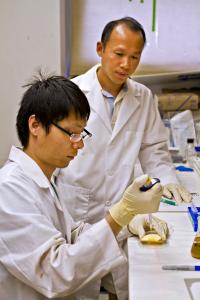Home > Press > Toxic nanoparticles might be entering human food supply: Scientists develop new way to detect threatening nanoparticles in food
 |
| Following a new study at the University of Missouri, a reliable method of testing foods for the harmful particles has been found that might be implemented in the future.
Credit: University of Missouri |
Abstract:
Over the last few years, the use of nanomaterials for water treatment, food packaging, pesticides, cosmetics and other industries has increased. For example, farmers have used silver nanoparticles as a pesticide because of their capability to suppress the growth of harmful organisms. However, a growing concern is that these particles could pose a potential health risk to humans and the environment. In a new study, researchers at the University of Missouri have developed a reliable method for detecting silver nanoparticles in fresh produce and other food products.
Toxic nanoparticles might be entering human food supply: Scientists develop new way to detect threatening nanoparticles in food
Columbia, MO | Posted on August 22nd, 2013"More than 1,000 products on the market are nanotechnology-based products," said Mengshi Lin, associate professor of food science in the MU College of Agriculture, Food and Natural Resources. "This is a concern because we do not know the toxicity of the nanoparticles. Our goal is to detect, identify and quantify these nanoparticles in food and food products and study their toxicity as soon as possible."
Lin and his colleagues, including MU scientists Azlin Mustapha and Bongkosh Vardhanabhuti, studied the residue and penetration of silver nanoparticles on pear skin. First, the scientists immersed the pears in a silver nanoparticle solution similar to pesticide application. The pears were then washed and rinsed repeatedly. Results showed that four days after the treatment and rinsing, silver nanoparticles were still attached to the skin, and the smaller particles were able to penetrate the skin and reach the pear pulp.
"The penetration of silver nanoparticles is dangerous to consumers because they have the ability to relocate in the human body after digestion," Lin said. "Therefore, smaller nanoparticles may be more harmful to consumers than larger counterparts."
When ingested, nanoparticles pass into the blood and lymph system, circulate through the body and reach potentially sensitive sites such as the spleen, brain, liver and heart.
The growing trend to use other types of nanoparticles has revolutionized the food industry by enhancing flavors, improving supplement delivery, keeping food fresh longer and brightening the colors of food. However, researchers worry that the use of silver nanoparticles could harm the human body.
"This study provides a promising approach for detecting the contamination of silver nanoparticles in food crops or other agricultural products," Lin said.
Members of Lin's research team also included Zhong Zang, a food science graduate student. The study was published in the Journal of Agricultural and Food Chemistry.
####
For more information, please click here
Contacts:
Christian Basi
573-882-4430
Copyright © University of Missouri-Columbia
If you have a comment, please Contact us.Issuers of news releases, not 7th Wave, Inc. or Nanotechnology Now, are solely responsible for the accuracy of the content.
| Related News Press |
News and information
![]() Researchers develop molecular qubits that communicate at telecom frequencies October 3rd, 2025
Researchers develop molecular qubits that communicate at telecom frequencies October 3rd, 2025
![]() Next-generation quantum communication October 3rd, 2025
Next-generation quantum communication October 3rd, 2025
![]() "Nanoreactor" cage uses visible light for catalytic and ultra-selective cross-cycloadditions October 3rd, 2025
"Nanoreactor" cage uses visible light for catalytic and ultra-selective cross-cycloadditions October 3rd, 2025
Discoveries
![]() Researchers develop molecular qubits that communicate at telecom frequencies October 3rd, 2025
Researchers develop molecular qubits that communicate at telecom frequencies October 3rd, 2025
![]() Next-generation quantum communication October 3rd, 2025
Next-generation quantum communication October 3rd, 2025
![]() "Nanoreactor" cage uses visible light for catalytic and ultra-selective cross-cycloadditions October 3rd, 2025
"Nanoreactor" cage uses visible light for catalytic and ultra-selective cross-cycloadditions October 3rd, 2025
Announcements
![]() Rice membrane extracts lithium from brines with greater speed, less waste October 3rd, 2025
Rice membrane extracts lithium from brines with greater speed, less waste October 3rd, 2025
![]() Researchers develop molecular qubits that communicate at telecom frequencies October 3rd, 2025
Researchers develop molecular qubits that communicate at telecom frequencies October 3rd, 2025
![]() Next-generation quantum communication October 3rd, 2025
Next-generation quantum communication October 3rd, 2025
![]() "Nanoreactor" cage uses visible light for catalytic and ultra-selective cross-cycloadditions October 3rd, 2025
"Nanoreactor" cage uses visible light for catalytic and ultra-selective cross-cycloadditions October 3rd, 2025
Interviews/Book Reviews/Essays/Reports/Podcasts/Journals/White papers/Posters
![]() Spinel-type sulfide semiconductors to operate the next-generation LEDs and solar cells For solar-cell absorbers and green-LED source October 3rd, 2025
Spinel-type sulfide semiconductors to operate the next-generation LEDs and solar cells For solar-cell absorbers and green-LED source October 3rd, 2025
![]() Rice membrane extracts lithium from brines with greater speed, less waste October 3rd, 2025
Rice membrane extracts lithium from brines with greater speed, less waste October 3rd, 2025
Food/Agriculture/Supplements
![]() New imaging approach transforms study of bacterial biofilms August 8th, 2025
New imaging approach transforms study of bacterial biofilms August 8th, 2025
![]() SMART researchers pioneer first-of-its-kind nanosensor for real-time iron detection in plants February 28th, 2025
SMART researchers pioneer first-of-its-kind nanosensor for real-time iron detection in plants February 28th, 2025
![]() Silver nanoparticles: guaranteeing antimicrobial safe-tea November 17th, 2023
Silver nanoparticles: guaranteeing antimicrobial safe-tea November 17th, 2023
Safety-Nanoparticles/Risk management
![]() Onion-like nanoparticles found in aircraft exhaust May 14th, 2025
Onion-like nanoparticles found in aircraft exhaust May 14th, 2025
![]() Closing the gaps — MXene-coating filters can enhance performance and reusability February 28th, 2025
Closing the gaps — MXene-coating filters can enhance performance and reusability February 28th, 2025
|
|
||
|
|
||
| The latest news from around the world, FREE | ||
|
|
||
|
|
||
| Premium Products | ||
|
|
||
|
Only the news you want to read!
Learn More |
||
|
|
||
|
Full-service, expert consulting
Learn More |
||
|
|
||








